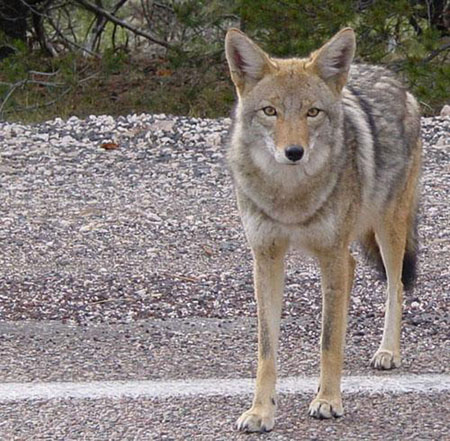



Coyote

Name: Coyote
Size: Coyotes typically grow up to 75–87 centimeters (30–34 inches) in length, not counting a tail of 30-40 cm (12-16 in), stand about 58-66 cm (23-26 in) at the shoulder and, on average, weigh from 7–21 kilograms (15–46 pounds). Northern coyotes are typically larger than southern subspecies, with the largest coyotes on record weighing 74¾ pounds (33.7 kg) and measuring over five feet in total length.
Habitat: Sightings now commonly occur in California, Oregon, New England, New Jersey, and eastern Canada. Coyotes have been seen in nearly every continental U.S. state, including Alaska. Coyotes have moved into most of the areas of North America formerly occupied by wolves, and are often observed foraging in suburban garbage bins.Coyotes also thrive in suburban settings and even some urban ones.Researchers estimate that there are up to 2,000 coyotes living in "the greater Chicago area" and that this circumstance may well apply to many other urban landscapes in North America.
Behavior: Coyote attacks on humans are uncommon and rarely cause serious injuries, due to the relatively small size of the coyote. Due to an absence of harassment by residents, urban coyotes lose their natural fear of humans, which is further worsened by people intentionally feeding coyotes. In such situations, some coyotes begin to act aggressively toward humans, chasing joggers and bicyclists, confronting people walking their dogs, and stalking small children. Urban coyotes tend to live longer than their rural counterparts, kill rodents and small pets, and live anywhere from parks to industrial areas. Though coyotes have been observed to travel in large groups, they primarily hunt in pairs.
Coyotes are primarily nocturnal but can often be seen during daylight hours. The gestation period lasts from 60 to 63 days. Litter size ranges from 1 to 19 pups; the average is 6. Hearing a coyote is much more common than seeing one. The calls a coyote makes are high-pitched and variously described as howls, yips, yelps and barks. These calls may be a long rising and falling note (a howl) or a series of short notes (yips). These calls are most often heard at dusk or night, but may be heard in the day. Although these calls are made throughout the year, they are most common during the spring mating season and in the fall when the pups leave their families to establish new territories. Coyotes are opportunistic, versatile carnivores with a 90% mammalian diet, depending on the season. They primarily eat small mammals, such as voles, prairie dogs, eastern cottontails, ground squirrels, and mice, though they will eat birds, snakes, lizards, deer, javelina, and livestock as well as large insects and other large invertebrates. Any species of bird that nests on the ground are targeted by coyotes. Though they will consume large amounts of carrion, they tend to prefer fresh meat. Part of the coyote's success as a species is its dietary adaptability. As such, coyotes have been known to eat human rubbish and domestic pets. Fruits and vegetables are a significant part of the coyote's diet in the autumn and winter months. Coyotes are presently the most abundant livestock predators in western North America, causing the majority of sheep, goat and cattle losses. Coyotes are an important furbearer in the region. Today, coyote fur is still used for full coats and trim and is particularly popular for men’s coats.
Some Links to information about Coyotes:
- Coyote and Fox, Arizona Sonora Desert Museum
- Coyote, University of Michigan Animal Diversity Web
Photo Credits:
Coyote - Marya (Creative Commons Attribution 2.0 License).The information on this page was taken from Wikipedia under a GNU Free Documentation License unless otherwise noted.









